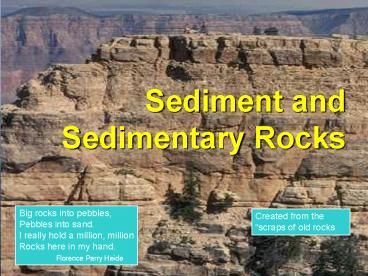Sediment and Sedimentary Rocks - PowerPoint PPT Presentation
1 / 11
Title:
Sediment and Sedimentary Rocks
Description:
Sediment and Sedimentary Rocks Big rocks into pebbles, Pebbles into sand. I really hold a million, million Rocks here in my hand. Florence Parry Heide – PowerPoint PPT presentation
Number of Views:62
Avg rating:3.0/5.0
Title: Sediment and Sedimentary Rocks
1
- Sediment and Sedimentary Rocks
Big rocks into pebbles, Pebbles into sand. I
really hold a million, million Rocks here in my
hand. Florence Parry Heide
Created from the scraps of old rocks
2
Sedimentary RocksTerms
- Regolith rock and mineral fragments produced by
weathering - Sediment regolith that has been transported by
wind, water or ice - Soil portion of regolith that supports plant life
3
Sedimentary Rocks Characteristics
- Loose, solid particles
- sediments
- Unconsolidated
- Classified based on size of individual fragments
4
Four Fundamental Components of Sedimentary Rocks
- Grains/Clasts sand, gravel or fossils
- Matrix fine grained clay-sized sediment
- Cement chemically precipitated mineral material
- Porosity space with no mineral matter
Cement
Clasts, matrix and iron oxide cement (reddish
brown colour)
5
Types of Sedimentary Rocks
- 2 main types of sedimentary rocks (based on
composition) - Clastic
- Inorganic sediments
- rocks made up of broken and worn particles of
rocks and minerals - Non-Clastic
- Organic sediments
- sediment precipitates from solution in water
originating from chemical and organic processes
Breccia
Chert from Will County, Illinois
6
Characteristics of Clastic Sediment
- Clastic sediment is divided into four main size
classes (based on texture as well) - Gravel
- Sand
- Silt
- Clay
Bedrock outcrop
River gravel
Beach sand
Clayey silt
Marine clay
7
Properties of Clastic Sedimentary Rock
- Processes
- Lithification / Diagenisis
- Compaction
- Pressure from recent, overlying sediment
- Cementation
- Hardening
- Stratification
- Layering
8
How Clastic Sedimentary Rock Form
- Clastic sedimentary rocks originate because of
- Weathering
- Erosion/Transportation
- Deposition/Burial
- Lithification / Diagenesis
9
Weathering
- Destroying rock
The rocks that make high ridges are much more
resistant to weathering than the surrounding
rocks
10
Erosion and Transport
- Sediments on the move
This stream carries sediment that has weathered
from nearby mountains at Polychrome Pass, Alaska
11
Deposition/Burial
- Sediments settling down
These pebbles were deposited in a stream that
once flowed over this area in Indiana, USA
thousands of years ago. Now they are part of a
clastic sedimentary rock called conglomerate































